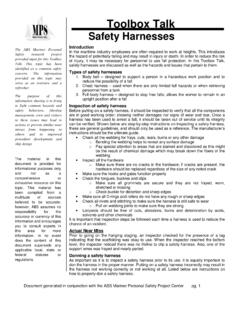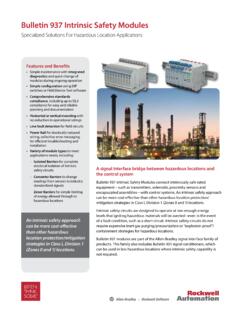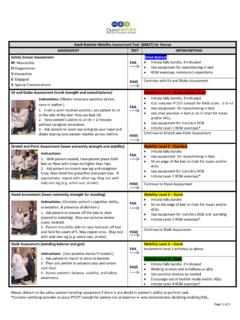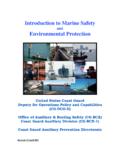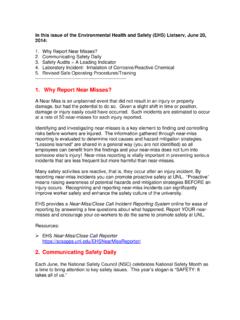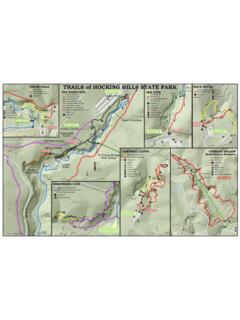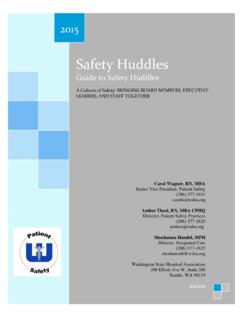Transcription of Basic NHRA Safety Rules - Hot Rod Network
1 Basic NHRA Safety Rules All cars must meet NHRA Rules and pass technical inspectionThis is general information only and you should always refer to the current "Official NHRA Rule Book". Street Cars The following items are required for a vehicle and driver to pass tech: Good tires, a solid battery hold down, radiator overflow reservoir, functioning neutral- Safety switch, seat belts, and a valid state driver's license or NHRA competition license for all participants. The driver must wear long pants, closed toe shoes, and a shirt. seconds ( 1/8th) Drive Line Loop with slicks Approved helmet (Full face in open cars), see below SFI Jacket in vehicles equipped with non-OEM nitrous oxide, turbochargers or superchargers seconds ( 1/8th) Roll bar in convertibles SFI seat belts in convertibles seconds ( 1/8th) Steel Valve Stems Arm Restraints (open cars) seconds ( 1/8th) SFI or Flywheel / Clutch SFI , , or Flywheel shield SFI approved jacket 6 point roll bar SFI approved seat belts seconds ( 1/8th) or Super Street SFI Transmission Shield, or at 135 mph Locking transmission dipstick tube Aftermarket axles and axle retainers SFI Harmonic Balancer Roll Cage with altered floor pans, or 135 mph - Window net required Ignition cut-off on all bikes / snowmobiles that exceed 135 mph seconds ( 1/8th)
2 Or Super Gas or 135 mph NHRA Chassis Certification NHRA Competition License SFI jacket & pants SFI neck collar & gloves SFI flexplate / flexplate shield (AT equipped cars) Full Face Helmet meeting Snell or SFI specifications 150 mph Parachute License Drivers 16 and 17 years of age must have a valid waiver signed by both parents to participate as a driver or passenger. Virtually anyone can compete in drag racing. Drivers 18 years of age and over are required to have Valid State Driver License, and must be capable of the safe operation of their vehicle. Vehicles running (Elapsed Time) and quicker require a NHRA Competition License and the chassis must have a current NHRA Chassis Certification. Auto Trans Reverse Lockout Any non-OEM (ie aftermarket) automatic floor-mounted transmission shifter must be equipped with a spring-loaded, positive reverse lockout device to prevent the shifter from accidentally being put in reverse gear.
3 A functional neutral Safety switch is also required. Roll Bars Unless otherwise required by your class, 6 point roll bars are required on convertibles running quicker than Roll Bar required on all cars (including T-tops) running quicker than Roll Cages Roll Cages required on convertibles running or faster than 135mph. Roll Cages required on all cars running * or faster than 135mph. *One exception: full-bodied cars running between and , with unaltered firewalls, floor and body (fromfirewall rearward - wheel tubes permitted) can compete with just a roll running (Elapsed Time) and quicker require a NHRA Competition License and the chas sis must have a current NHRA Chassis Certification. Helmets Drivers of all or quicker cars, including motorcycles, must wear a helmet meeting Snell or SFI Specifications. Full-face helmet mandatory on all cars (1/4 mile) (1/8 mile) or quicker.
4 See individual Class Requirements for additional requirements, such as Stock Eliminator. Shield mandatory (1/4 mile) and quicker. Drivers of NHRA Lucas Oil Drag Racing Series and cars ( or quicker) (* ) must use a helmet meeting Snell SA2010, M2010, or SFI , or Specs. Drivers in supercharged, front engine, open-bodied cars andFunny Cars must wear a helmet meeting Snell SA2010, SAH2010, or SFI Nitrous Oxide Commercially available nitrous oxide permitted, including supercharged and turbocharged engines. Nitrous bottle(s) in driver compartment must be equipped with a relief valve and vented outside of driver s compartment. Bottle(s) must be stamped with a DOT-1800 pound rating and permanently mounted (no hose clamps or tie wraps). Hoses from bottle(s) to solenoid must be high-pressure steel-braided or NHRA-accepted hoses. Commercially available, thermostatically controlled, blanket-type warmer accepted.
5 Any other external heating of bottle prohibited, torches absolutely forbidden. Liquid Overflow All cars must have a recovery system or catch can (minimum of 16 oz.) for the car's radiator. Drive-shaft loop For cars with driveshafts that contain universal joints: For all full-bodied and open-bodied cars running between (* ) and (* ) in place of a crossmember located behind but within 6 inches of the center of the front universal joint: A front driveshaft loop is required on all cars, except vehicles running (* ) seconds or slower equipped with street tires. Battery Relocation If the battery is not in the stock location, and relocated to the trunk, for example, you must have an external cut-off switch on the back of the car which cuts off the electrical system and must also stop the car from running. Seat Belts All cars must be equipped with an accepted quick release type driver seat belt.
6 All cars in competition requiring a roll bar or roll cage, or as outlined by Class Requirements, require a Driver Restraint System as outlined below. Driver Restraint Systems A quick-release, 3-inch shoulder harness meeting SFI Spec , including crotch strap, is mandatory in all cars in competition required by the Rules to have a roll bar or a roll cage. Driver restraint system must be clearly labeled as meeting SFI Spec and be dated by manufacturer. System must be updated at two-year intervals from date of manufacture. All seat belt and shoulder harness installations must be mutually compatible, originally designed to be used with each other, and produced by the same manufacturer. Cars using OEM or OEM type seat may route crotch strap in front of seat instead of through seat. Only those units that release all five attachment points in one motion are permitted. When arm restraints are worn with a restraint system that utilizes a "latch lever", a protective cover must be installed to prevent arm restraint from accidentally releasing the latch lever.
7 Protective cover not needed if system uses "duckbill" latch hardware. All harness sections must be mounted to the frame, cross member, or reinforced mounting, and installed to limit driver's body travel both upward and forward. Seat belts may not be wrapped around lower frame rails. Under no circumstances are bolts inserted through belt webbing permitted for mounting. Check manufacturer s instructions. Wheels & Lug Nuts All wheels must have ALL lug nuts in place and securely fastened. All street tires must have minimum 1/16 inch tread depth. Vehicles with slicks must have open ended lug nuts. The thread engagement on all wheel studs to the lug nut, or lug bolts to wheel hubs, must be equivalent to or greater than the diameter of the stud/bolt. Length of the stud/bolt does not determine permissibility. (Example: A 7/16-inch stud must be thoroughly engaged through the threads in the hex portion of the lug a minimum of 7/16-inch.)
8 Section 22, page 3 Charts and Formulas Item to to to to to & Slower Expiration Master Electrical Cutoff Switch Y Y 8:4 / 135 mph 8:4 8:4 8:4 Neck Collar (SFI ) Y Y 10:8 10:8 10:8 10:8 NHRA Competition License Y Y 10:4 10:4 10:4 10:4 NHRA Chassis Sticker Y Y 4:4 4:4 4:4 4:4 Padding Roll Bar/Cage Y / SFI Y / SFI Y / SFI Y 10:6 / 135 mph 10:6 / 135 mph Parachute Y Y / 150 mph 4:8 4:8 4:8 4:8 Pressurized Bottles DOT (1800) Y Y Y Y Y Y Protective Clothing Y Y Y Y 10:10 10:10 SFI ; ; ; Driver s Suit5 years, incl. year on tag Roll Bar Y Y C / 4:10 Roll Cage Y Y Y / 135 mph 4:11 4:11 4:11 SFI Chassis Specification Y 4:4 / 180 mph 4:4 4:4 4:4 4:4 SFI ; ; ; ; ; Full Body Chassis Spec; Pro Stock1 year SFI ; ; ; ; ; ; ; Adv. ; ; ; ; 3 years Supercharger Restraints Y 1:11 1:11 1:11 1:11 1:11 2 years (SFI ; ; ; ) Taillight Y Y Y Y Y Y Transmission Flexplate (SFI ) Y Y 2:14 2:14 2:14 2:14 3 years Transmission Locking-Type Dipstick Y Y Y Transmission Reverse Lockout Y Y Y Y Y Y Transmission Shield (SFI ) Y Y Y 2:14 2:14 2:14 Rigid, 5 yrs.
9 ; Flexible, 2 yrs. Window Net Full-Bodied Cars Y Y 6:3 / 10:3 6:3 / 10:3 6:3 / 10:3 6:3 / 10:3 Thank you for being an NHRA Member. It is always our privilege to serve you. To renew or join, visit and Formulas Section 22, page 4 Charts and Formulas 2018 NHRA QUICK REFERENCE CHART & SFI EXPIRATIONS Y = Required C = Convertibles Numbers Refer to General Regulations Years Refer to SFI Expirations In no way is this Quick Reference Chart intended to supersede or replace the current NHRA Rulebook (quarter-mile )Unless otherwise noted in this , Quick Reference Chart, refer to for the latest version of all non-chassis specifications. Also, unless otherwise noted in this document, refer to for the latest SFI chassis specification versions. Note: Only certified NHRA chassis inspectors and authorized NHRA officials have access to An item with an expiration period must be returned to the original manufacturer for inspection and recertification at the end of this period before it can be permitted for further use at an NHRA event.
10 Item to to to to to & Slower Expiration Aftermarket Rear Axles Y Y Y 2:11 2:11 2:11 Arm Restraints (Open-Bodied Cars) Y Y Y Y 10:3 / 10:3 Bellhousing (SFI ; ) Y Y Y Y 2:10 2:10 Driver Restraint System (SFI ; ) Y Y Y / 10:5 Y / 10:5 C / 10:5 10:5 / 10:11 2 years Driveshaft Loop Y Y Y Y 2:4 2:4 Electric Vehicle & Quicker Y Y Y Y Y 2:4 Flexplate Shield (SFI ) Y Y 2:14 2:14 2:14 2:14 5 years Flywheel/Clutch (SFI ; ) Y Y Y Y 2:5 2:5 2 years SFI : Single-Disc Clutch & Flywheel Assembly, : Multi-Disc Clutch & Flywheel Assembly through Comp, PS Flywheel Shield (SFI ; ; ; ) Y Y Y Y 2:10 2:10 SFI : Flywheel Shield, Spec & (2-Disc Max. or 3-Disc, 8-inch Diameter Max.) 5 years SFI : Flywheel Shield, Spec , , & Clutch (Check with Manufacturer; May Be Only 1 Year) 2 years Harmonic Balancer (SFI ) Y Y Y Permitted Permitted Permitted Head & Neck Restraint Device/System (SFI ) Y 10:8 / 200 mph 10:8 10:8 10:8 10:8 5 years Helmet Y Y Y Y Y 10:7 SFI ; ; ; Snell 2010exp.


